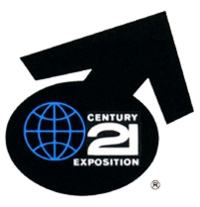| 1962 Seattle | |
|---|---|
 Century 21 Exposition logo | |
| Overview | |
| BIE-class | Universal exposition |
| Category | Second category General Exposition |
| Name | Century 21 Exposition |
| Motto | Living in the Space Age |
| Building(s) | Space Needle and Washington State Pavilion |
| Area | 74 acres (30 hectares) |
| Invention(s) | Bubbleator, Friendship 7 |
| Visitors | 9,609,969 |
| Organized by | Edward E. Carlson |
| Participant(s) | |
| Countries | 24 |
| Location | |
| Country | United States |
| City | Seattle |
| Venue | Broad Street |
| Coordinates | 47°37′17″N 122°21′03″W / 47.62139°N 122.35083°W |
| Timeline | |
| Bidding | 1955 |
| Opening | April 21, 1962 |
| Closure | October 21, 1962 |
| Universal expositions | |
| Previous | Expo 58 in Brussels |
| Next | Expo 67 in Montreal |
The Century 21 Exposition (also known as the Seattle World's Fair) was a world's fair held April 21, 1962, to October 21, 1962, in Seattle, Washington, United States.[1][2] Nearly 10 million people attended the fair during its six-month run.[3]
As planned, the exposition left behind a fairground and numerous public buildings and public works; some credit it with revitalizing Seattle's economic and cultural life (see History of Seattle since 1940).[4] The fair saw the construction of the Space Needle and Alweg monorail, as well as several sports venues (Washington State Coliseum, now Climate Pledge Arena) and performing arts buildings (the Playhouse, now the Cornish Playhouse), most of which have since been replaced or heavily remodeled. Unlike some other world's fairs of its era, Century 21 made a profit.[3]

The site, slightly expanded since the fair, is now called Seattle Center; the United States Science Pavilion is now the Pacific Science Center. Another notable Seattle Center building, the Museum of Pop Culture (earlier called EMP Museum), was built nearly 40 years later and designed to fit in with the fairground atmosphere.
- ^ Official Guide Book, cover and passim.
- ^ Guide to the Seattle Center Grounds Photograph Collection: April, 1963 Archived March 27, 2008, at the Wayback Machine, University of Washington Libraries Special Collections. Accessed online October 18, 2007.
- ^ a b Joel Connelly, Century 21 introduced Seattle to its future Archived September 14, 2012, at archive.today, Seattle Post-Intelligencer, April 16, 2002. Accessed online October 18, 2007.
- ^ Regina Hackett, City's arts history began a new chapter in '62 Archived May 27, 2012, at archive.today, Seattle Post-Intelligencer, April 29, 2002. Accessed online October 18, 2007.